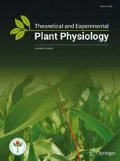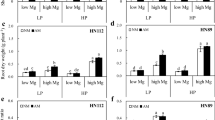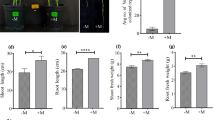Abstract
Roots acquire phosphorus (P) as orthophosphate (Pi) through phosphate transporters of the PHT1 family with different affinities to Pi, a process significantly influenced by arbuscular mycorrhizal (AM) symbiosis. However, scarce P availability may constrain nodulation and performance in legumes. Soybean (Glycine max) is an ideal model to study tripartite symbiosis between roots, AM fungi and rhizobia. To evaluate AM influence on GmPHT1 expression in roots and nodules, Bradyrhizobium elkanii-inoculated soybean plants were exposed to low Pi concentration (50 µM) via nutrient solution and inoculated (+ AM) or not (− AM) with the AM fungus Glomus macrocarpum. Control treatment consisted of non-inoculated plants grown under sufficient P conditions (500 µM; − AM + P). Plants were collected at the flowering and grain filling stages. Under P-starvation, mycorrhizal plants showed low intraradical colonization and did not differ in terms of biomass, nodulation and P content from the non-mycorrhizal plants, indicating strong P-limitation and no AM-related growth promotion. However, the expression profile of PHT1 transporters in roots and nodules was effectively altered by mycorrhization. P-starvation induced the expression of several GmPHT1 genes in roots and nodules, while AM symbiosis repressed GmPHT1;6, 7 and 10 in roots and GmPHT1;3, 5, 7, 8, and 10 in nodules. Therefore, even under low levels of root colonization, AM symbiosis significantly modulated the pattern of PHT1 expression under P-starvation. GmPHT1 expression profile suggests different pathways of Pi acquisition in mycorrhizal and non-mycorrhizal plants during P-starvation, however, the low mycorrhizal colonization was not able to deliver adequate P nutrition to the plant.




Similar content being viewed by others
References
Asimi S, Gianinazzi-Pearson V, Gianinazzi S (1980) Influence of increasing soil phosphorus levels on interactions between vesicular–arbuscular mycorrhizae and Rhizobium in soybeans. Can J Bot 58:2200–2205. https://doi.org/10.1139/b80-253
Azcón R, Rúbio R, Barea JM (1991) Selective interactions between different species of mycorrhizal fungi and Rhizobium meliloti strains, and their effects on growth, N2-fixation (15N) and nutrition of Medicago sativa L. New Phytol 117:399–404. https://doi.org/10.1111/j.1469-8137.1991.tb00003.x
Ballhorn DJ, Schädler M, Elias JD et al (2016) Friend or foe—light availability determines the relationship between Mycorrhizal Fungi, Rhizobia and Lima Bean (Phaseolus lunatus L.). PLoS ONE 11:e0154116. https://doi.org/10.1371/journal.pone.0154116
Bremner JM (1965) Total nitrogen. In: Black CA (ed) Methods of soil analysis. American Society of Agronomy, Madison, pp 1149–1178
Bulgarelli RG, Marcos FCC, Ribeiro RV, de Andrade SAL (2017) Mycorrhizae enhance nitrogen fixation and photosynthesis in phosphorus-starved soybean (Glycine max L. Merrill). Environ Exp Bot 140:26–33. https://doi.org/10.1016/j.envexpbot.2017.05.015
Catford JG, Staehelin C, Lerat S, Piche Y, Vierheilig H (2003) Suppression of arbuscular mycorrhizal colonization and nodulation in split-root systems of alfalfa after pre-inoculation and treatment with Nod factors. J Exp Bot 54:1481–1487. https://doi.org/10.1093/jxb/erg156
Catford JG, Staehelin C, Larose G, Piche Y, Vierheilig H (2006) Systemically suppressed isoflavonoids and their stimulating effects on nodulation and mycorrhization in alfalfa split-root systems. Plant Soil 285:257–266. https://doi.org/10.1007/s11104-006-9012-8
Derveaux S, Vandesompele J, Hellemans J (2010) How to do successful gene expression analysis using real-time PCR. Methods 50:227–230. https://doi.org/10.1016/j.ymeth.2009.11.001
Elser JJ, Bracken MES, Cleland EE et al (2007) Global analysis of nitrogen and phosphorus limitation of primary producers in freshwater, marine and terrestrial ecosystems. Ecol Lett 10:1135–1142. https://doi.org/10.1111/j.1461-0248.2007.01113.x
Fan C, Wang X, Hu R et al (2013) The pattern of phosphate transporter 1 genes evolutionary divergence in Glycine max L. BMC Plant Biol 13:48. https://doi.org/10.1186/1471-2229-13-48
Fehr WR, Caviness CE, Burmood DT, Pennington JS (1971) Stage of development descriptions for soybeans, Glycine max (L.) Merrill. Crop Sci 11:929–931. https://doi.org/10.2135/cropsci1971.0011183X001100060051x
Garcia K, Doidy J, Zimmermann SD, Wipf D, Courty PE (2016) Take a trip through the plant and fungal transportome of mycorrhiza. Trends Plant Sci 21:937–950. https://doi.org/10.1016/j.tplants.2016.07.010
Gavito ME, Jakobsen I, Mikkelsen TN, Mora F (2019) Direct evidence for modulation of photosynthesis by an arbuscular mycorrhiza-induced carbon sink strength. New Phytol. https://doi.org/10.1111/nph.15806
Giovannetti M, Mosse B (1980) Evaluation of techniques for measuring vesicular arbuscular mycorrhizal infection in roots. New Phytol 84:489–500. https://doi.org/10.1111/j.1469-8137.1980.tb04556.x
Grace EJ, Cotsaftis O, Tester M, Smith FA, Smith SE (2009) Arbuscular mycorrhizal inhibition of growth in barley cannot be attributed to extent of colonization, fungal phosphorus uptake or effects on expression of plant phosphate transporter genes. New Phytol 181:938–949. https://doi.org/10.1111/j.1469-8137.2008.02720.x
Gu M, Chen A, Sun S, Xu G (2016) Complex regulation of plant phosphate transporters and the gap between molecular mechanisms and practical application: what is missing? Mol Plant 9:396–416. https://doi.org/10.1016/j.molp.2015.12.012
Harris D, Pacovsky RS, Paul EA (1985) Carbon economy of soybean-Rhizobium-Glomus association. New Phytol 101:427–440. https://doi.org/10.1111/j.1469-8137.1985.tb02849.x
Harrison MJ (2005) Signaling in the arbuscular mycorrhizal symbiosis. Annu Rev Microbiol 59:19–42. https://doi.org/10.1146/annurev.micro.58.030603.123749
Hellemans J, Mortier G, De Paepe A et al (2007) qBase relative quantification framework and software for management and automated analysis of real-time quantitative PCR data. Genome Biol 8:R19. https://doi.org/10.1186/gb-2007-8-2-r19
Hoagland DR, Arnon DI (1950) The water culture method for growing plants without soil. Circular. California agricultural experimental station, 2nd edn, p 347
Inoue Y, Kobae Y, Omoto E et al (2014) The soybean mycorrhiza-inducible phosphate transporter gene, GmPT7, also shows localized expression at the tips of vein endings of senescent leaves. Plant Cell Physiol 55:2102–2111. https://doi.org/10.1093/pcp/pcu138
Jian B, Liu B, Bi Y, Hou W, Wu C, Han T (2008) Validation of internal control for gene expression study in soybean by quantitative real-time PCR. BMC Mol Biol 9:59. https://doi.org/10.1186/1471-2199-9-59
Kafle A, Garcia K, Wang X et al (2019) Nutrient demand and fungal access to resources control the carbon allocation to the symbiotic partners in tripartite interactions of Medicago truncatula. Plant Cell Environ 42:270–284. https://doi.org/10.1111/pce.13359
Kaschuk G, Kuyper TW, Leffelaar PA, Hungria M, Giller KE (2009) Are the rates of photosynthesis stimulated by the carbon sink strength of rhizobial and arbuscular mycorrhizal symbioses? Soil Biol Biochem 41:1233–1244. https://doi.org/10.1016/j.soilbio.2009.03.005
Kassaw T, Bridges W Jr, Frugoli J (2015) Multiple autoregulation of nodulation (AON) signals identified through split root analysis of Medicago truncatula sunn and rdn1 Mutants. Plants 4: 209–224. https://doi.org/10.3390/plants4020209
Koide RT, Schreiner P (1992) Regulation of the vesicular-arbuscular mycorrhizal symbiosis. Annu Rev Plant Physiol Plant Mol Biol 43:557–581. https://doi.org/10.1146/annurev.pp.43.060192.003013
Larimer AL, Clay K, Bever JD (2014) Synergism and context dependency of interactions between arbuscular mycorrhizal fungi and rhizobia with a prairie legume. Ecology 95:1045–1054. https://doi.org/10.1890/13-0025.1
Li C, Gui S, Yang T et al (2012) Identification of soybean purple acid phosphatase genes and their expression responses to phosphorus availability and symbiosis. Ann Bot 109:275–285. https://doi.org/10.1093/aob/mcr246
Loth-Pereda V, Orsini E, Courty PE et al (2011) Structure and expression profile of the phosphate Pht1 transporter gene family in mycorrhizal Populus trichocarpa. Plant Physiol 156:2141–2154. https://doi.org/10.1104/pp.111.180646
Meena RS, Vijayakumar V, Yadav GS, Mitran T (2018) Response and interaction of Bradyrhizobium japonicum and arbuscular mycorrhizal fungi in the soybean rhizosphere. Plant Growth Regul 84:207–223. https://doi.org/10.1007/s10725-017-0334-8
Nussaume L, Kanno S, Javot H et al (2011) Phosphate import in plants: focus on the PHT1 transporters. Front Plant Sci 2:83. https://doi.org/10.3389/fpls.2011.00083
Penheiter AR, Duff SMG, Sarath G (1997) Soybean root nodule acid phosphatase. Plant Physiol 114:597–604
Perez-Fernandez M, Miguez-Montero A, Valentine A (2019) Phosphorus and nitrogen modulate plant performance in shrubby legumes from the iberian peninsula. Plants 8:334. https://doi.org/10.3390/plants8090334
Plassard C, Becquer A, Garcia K (2019) Phosphorus transport in mycorrhiza: how far are we? Trends Plant Sci 24:794–801. https://doi.org/10.1016/j.tplants.2019.06.004
Pumplin N, Harrison MJ (2009) Live-cell imaging reveals periarbuscular membrane domains and organelle location in Medicago truncatula roots during arbuscular mycorrhizal symbiosis. Plant Physiol 151:809–819. https://doi.org/10.1104/pp.109.141879
Qin L, Zhao J, Tian J et al (2012) The high-affinity phosphate transporter GmPT5 regulates phosphate transport to nodules and nodulation in soybean. Plant Physiol 159:1634–1643. https://doi.org/10.1104/pp.112.199786
Roch GV, Maharajan T, Ceaser SA, Ignacimuthu S (2019) The role of PHT1 family transporters in the acquisition and redistribution of phosphorus in plants. Crit Rev Plant Sci 38:1–28. https://doi.org/10.1080/07352689.2019.1645402
Sisaphaithong T, Kondo D, Matsunaga H, Kobae Y, Hata S (2012) Expression of plant genes for arbuscular mycorrhiza-inducible phosphate transporters and fungal vesicle formation in sorghum, barley, and wheat roots. Biosci Biotechnol Biochem 76:2364–2367. https://doi.org/10.1271/bbb.120782
Smith FA, Smith SE (2013) How useful is the mutualism-parasitism continuum of arbuscular mycorrhizal functioning? Plant Soil 363:7–18. https://doi.org/10.1007/s11104-012-1406-1
Smith SE, Smith FA (2011) Roles of arbuscular mycorrhizas in plant nutrition and growth: new paradigms from cellular to ecosystem scales. Annu Rev Plant Biol 62:227–250. https://doi.org/10.1146/annurev-arplant-042110-103846
Smith SE, Smith FA (2012) Fresh perspectives on the role of arbuscular mycorrhizal fungi in plant nutrition and growth. Mycologia 104:1–13. https://doi.org/10.3852/11-229
Sulieman S, Ha CV, Schulze J, Tran LSP (2013) Growth and nodulation of symbiotic Medicago truncatula at different levels of phosphorus availability. J Exp Bot 64:2701–2712. https://doi.org/10.1093/jxb/ert122
Tamura Y, Kobae Y, Mizuno T, Hata S (2012) Identification and expression analysis of arbuscular mycorrhiza-inducible phosphate transporter genes of soybean. Biosci Biotechnol Biochem 76:309–313. https://doi.org/10.1271/bbb.110684
Trouvelot A, Kough JL, Gianinazzi-Pearson V (1986) Mesure du taux de mycorhization VA d’un système radiculaire. Recherche de méthodes d’estimation ayant une signification fonctionnelle. Physiol Genet Asp mycorrhizae INRA, Paris, pp 217–221
Vance CP, Uhde-Stone C, Allan DL (2003) Phosphorus acquisition and use: critical adaptations by plants for securing a nonrenewable resource. New Phytol 157:423–447. https://doi.org/10.1046/j.1469-8137.2003.00695.x
Vandesompele J, De Preter K, Pattyn F et al (2002) Accurate normalization of real-time quantitative RT-PCR data by geometric averaging of multiple internal control genes. Genome Biol. https://doi.org/10.1186/gb-2002-3-7-research0034
Xavier LJC, Germida JJ (2003) Selective interactions between arbuscular mycorrhizal fungi and Rhizobium leguminosarum bv. viceae enhance pea yield and nutrition. Biol Fertil Soils 37:261–267. https://doi.org/10.1007/s00374-003-0605-6
Xue Y, Zhuang Q, Zhu S et al (2018) Genome wide transcriptome analysis reveals complex regulatory mechanisms underlying phosphate homeostasis in soybean nodules. Int J Mol Sci 19:2924. https://doi.org/10.3390/ijms19102924
Acknowledgements
This work was financially supported by a Grant from the São Paulo Research Foundation FAPESP (Grant 2016/06396-1). The authors acknowledge the National Council for Scientific and Technological Development (CNPq, Brazil) for the studentship awarded to RGB. We would like to thank Dr. Leandro Carrijo Cintra from Embrapa Agricultural Informatics for his help in generating the heatmap figure, and our special thanks to Dr. Tandra Fraser (Agriculture and Agri-Food Canada), who kindly revised the English language in the last version of the manuscript.
Author information
Authors and Affiliations
Contributions
SALA conceptualized and designed experiments; RGB performed the experiments and the laboratory analyses; RGB, VHO, and SALA analyzed data and discussed the results, and SALA and VHO wrote the manuscript. All authors read, contributed to the drafts, and approved the final version of the manuscript.
Corresponding author
Ethics declarations
Conflict of interest
The authors declare no conflict of interest.
Additional information
Publisher's Note
Springer Nature remains neutral with regard to jurisdictional claims in published maps and institutional affiliations.
Electronic supplementary material
Below is the link to the electronic supplementary material.
Rights and permissions
About this article
Cite this article
Bulgarelli, R.G., De Oliveira, V.H. & de Andrade, S.A.L. Arbuscular mycorrhizal symbiosis alters the expression of PHT1 phosphate transporters in roots and nodules of P-starved soybean plants. Theor. Exp. Plant Physiol. 32, 243–253 (2020). https://doi.org/10.1007/s40626-020-00185-8
Received:
Accepted:
Published:
Issue Date:
DOI: https://doi.org/10.1007/s40626-020-00185-8




